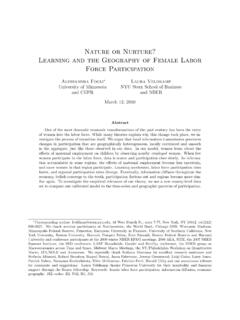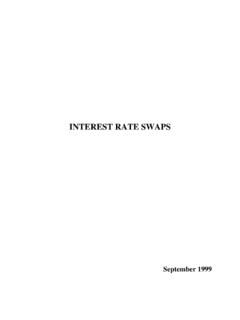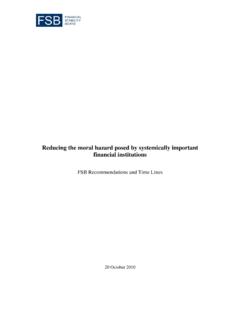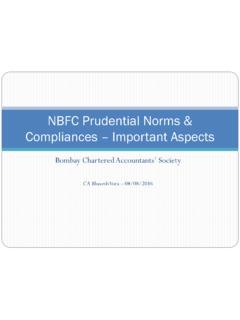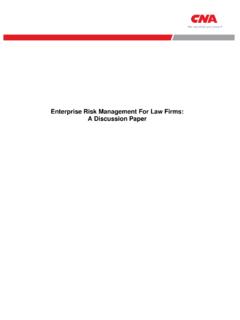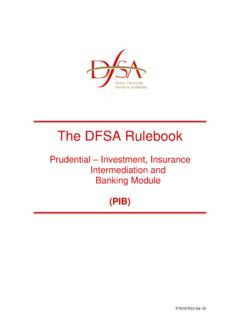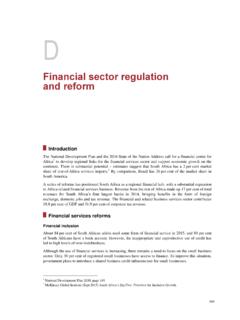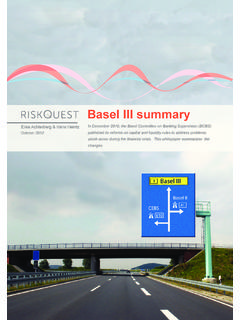Transcription of Are Insurance Firms Systemically Important? - NYU
1 Are Insurance Firms Systemically important ? Viral V Acharya (NYU-Stern, CEPR and NBER). Based on Chapter 9. Is the Insurance Industry Systemically Risky? with Matt Richardson in Modernizing Insurance Regulation, John Biggs and Matth Richardson, eds, John Wiley and Sons, Inc., forthcoming What is systemic risk ? Micro-prudential view: Contagion Failure of an entity leads to distress or failures of others Macro-prudential view: Common factor exposures + Runs Several entities fail together as Short-term creditors demand immediacy Against long-term assets But the system has limited capacity (capital?) to provide immediacy The micro-prudential and macro-prudential views are not necessarily mutually exclusive What about contagion? Macro-prudential view: Contagion can amplify problems provided rest of the system cannot Withstand the distress or failures of others, , because it is under- capitalized too due to a common shock (AIG FP failure).
2 Re-intermediate the liquidated assets of distressed Firms (Lehman). Contagion can arise without inter-connections Information contagion Learning about common assets (Great Depression runs ). Flow of funds or re-intermediation contagion Insurance Firms withdraw from bonds inducing LC runs on banks NYU Stern Systemic Risk Rankings at SRISK = Capital shortfall of a financial firm relative to 8% market equity capitalization in an aggregate market crash of 40% over six month period SRISK: Capital shortfall in case of 40% market correction 60000. 50000. 40000. 30000. MET. PRU. 20000 HIG. LNC. PFG. 10000. 0. 1/3/06 1/3/07 1/3/08 1/3/09 1/3/10 1/3/11 1/3/12 1/3/13 1/3/14. -10000. -20000. SRISK: Capital shortfall in case of 40% market correction 200000.
3 150000. 100000. BAC. JPM. 50000 C. MS. GS. 0. 1/3/06 1/3/07 1/3/08 1/3/09 1/3/10 1/3/11 1/3/12 1/3/13 1/3/14. -50000. -100000. MES: %Loss of market value in case of 2% market correction MET. PRU. HIG. LNC. PFG. 0. 1/3/06 1/3/07 1/3/08 1/3/09 1/3/10 1/3/11 1/3/12 1/3/13 1/3/14. MES: %Loss of market value in case of 2% market correction BAC. JPM. C. MS. GS. 0. 1/3/06 1/3/07 1/3/08 1/3/09 1/3/10 1/3/11 1/3/12 1/3/13 1/3/14. LVG: (Book Liabilities + Mkt Equity) / Mkt Equity 250. 200. 150. MET. PRU. HIG. LNC. 100 PFG. 50. 0. 1/3/06 1/3/07 1/3/08 1/3/09 1/3/10 1/3/11 1/3/12 1/3/13 1/3/14. LVG: (Book Liabilities + Mkt Equity) / Mkt Equity 350. 300. 250. 200 BAC. JPM. C. MS. 150. GS. 100. 50. 0. 1/3/06 1/3/07 1/3/08 1/3/09 1/3/10 1/3/11 1/3/12 1/3/13 1/3/14.
4 Open questions (for Insurance Firms !). Why did market values of Insurance Firms collapse so much in Fall of 2008? Why did some of the Firms need TARP? Why are downside risk (MES) or beta estimates of Insurance Firms as high as those of banks and bank holding companies? Why were Insurance Firms owning banks, making guaranteed financial products, selling CDS, Why does capital shortfall of MetLife and Prudential show increase post 2010 when banks are de-leveraging? Open questions (for Insurance Firms !). If Insurance firm liabilities are more stable, won't they take advantage of that and keep less equity on balance- sheet a priori? Recent evidence that Insurance Firms engaging in capital-reducing and risk-enhancing strategies When market value of Insurance Firms collapse, won't that affect their corporate bond market purchases and potentially also result in fire sales, policy lapses, Insurance sector own $ of corporate and foreign bonds Won't lack of corporate bond market access cause Firms to draw down bank lines of credit causing bank runs ?
5 Is Insurance sector really not connected to the financial plumbing? Recent evidence Insurance Firms appear to be seeking risks like banks! Becker-Ivashina (HBS Working Paper, 2013): Insurance Firms search for yield in corporate bond holdings within a rating class Regulatory arbitrage subject to risk (ratings)-based capital requirements Shows capital efficiency or in other words leverage -building Behavior akin to that observed in banks Greater reaching for yield in economic expansions More by Insurance Firms closer to regulatory capital constraint Recent evidence Insurance Firms appear to be seeking risks like banks! Koijen-Yogo (FRB Working Paper, 2013): Insurance Firms deploy riskier, weakly-regulated, off- balance-sheet shadow Insurance or captive vehicles (in South Carolina, Vermont or off-shore): : MetLife owns affiliated firm that reinsurances MetLife!
6 $11 bln in 2002 to $363 bln in 2012. A benefit of three rating notches in AM Best (ignores shadows!!). Expected losses to state guarantee funds greater by $15bln Capital efficiency aka regulatory arbitrage has allowed the Insurance sector to free up reserves and increase its size Akin to bank-sponsored ABCP conduits, first runs of 2007? Recent evidence Insurance Firms appear to be seeking risks like banks! Becker-Opp (Berkeley Hass Working Paper, 2014): Capital requirements for RMBS holdings reduced dramatically while moving from ratings to prop measures Approx 20% of asset holdings of insurers in structured products 2009 reform by the NAIC reducing RMBS capital required by 67%. Capital calculation based on expected losses! What about unexpected losses ?
7 Flies in the face of basic principles of prudential capital requirements Capital calculation based on book value of asset rather than its risk! Asset held at purchase price in normal market has zero capital A capital relief (for large and perhaps distressed-in-2009 insurers). amounting to over $15 bln relative to the earlier risk-based system Conclusion The jury is still out on whether Insurance Firms are Systemically risky or not Their historical and current behavior does not give academics confidence that they are not SIFI candidates The regulatory and risk-taking practices at Insurance sector look as problematic as those at pre-crisis banks Crisis always happens in institutions and assets we make the mistake of treating as fail-safe !
8 I am not impressed! They take one class of securities and change the rules to give insurers capital relief. Let's just hope they aren't picking something out that results in inadequate capital.. I believe large Insurance Firms are prone to same risk- taking and capital-efficiency games as banks and should be subject to SIFI rules by the FSOC. SELF-REGULATION IS TO REGULATION AS. SELF-IMPORTANCE IS TO IMPORTANCE!.


